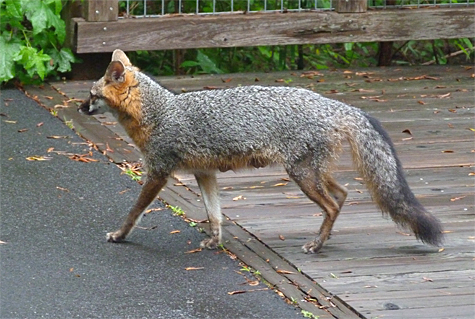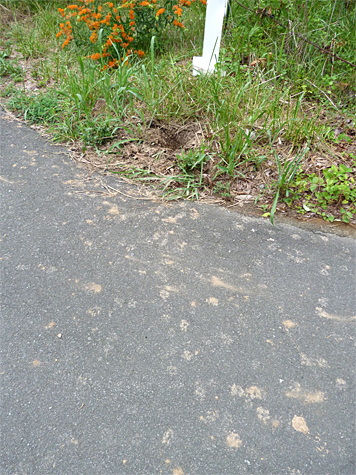I’ve seen zero activity this past week at either of the green heron nests in our Wetlands. I saw a heron flying away from the Wetlands Saturday (6/21) and one flew in to fish late in the day Wednesday (6/25).
What has happened to the two heron nests that were started, completed and in which eggs had been deposited, at least in the nest visible from the Main Wetlands Overlook. The other nest, which is difficult to see, was placed in a willow located on an island near the south side of the Wetlands. It may also have had eggs but those eggs were perhaps hidden from view. Activity seemed to halt at that nest the week before.

It looks as if both nests were the victims of predators. Raccoons, fox, crows, grackles, and snakes all enjoy eggs. Although raccoons and gray fox can climb trees, I doubt either of those residents of our Wetlands ventured out into the water and onto the willow trees to raid the heron nests.
Both fox and raccoon have young to feed at this time of year, but both of those critters are too busy digging up turtle nests to bother swimming out after a couple of heron eggs. Every morning I see one or more turtle’s nest dug up along the paths here at the Museum. I find unearthed turtle egg shells every day. The evidence is clear, a hole in the ground, egg shells strewn about, and ‘coon or fox tracks leading away from the scene are all one needs for a conviction of either of those animals.



So, the fox and raccoons are busy elsewhere and, although they could raid the herons’ nests they probably would rather not get wet when they have so many turtle eggs close by on dry land.
That leaves crows, grackles and snakes as the likely suspects. I see or hear crows at the Museum daily. They are crafty and can quickly and quietly slip in to take a nestling, or egg, right out of the nest. Crows can be very boisterous, but they can also be very quiet and stealthy when on a mission to rob nests.

Common Grackles are in and out of the Wetlands all day long at this time of year. They drop in to catch tadpoles, small fish or frogs. And although they sometimes eat the goodies on the spot, they usually bring them back to their nests to feed their young. Fresh heron eggs would be a bonus for these grackles.

The herons don’t leave their nests unattended for long. They stick close to the nest, even when stretching their legs and preening. Both crow and grackle would have to get in and out fast to rob the heron’s nest. They wouldn’t have the luxury to sit on the rim of the nest, crack open an egg and eat it on the spot. No, they’d have to snatch and carry the eggs away, with green herons in hot pursuit.
The nest at the Wetlands Overlook had no eggs at all on Saturday morning (6/21). It had at least two eggs the day before. The robbers, crow or grackle, would have had to have an accomplice, or carried away all the eggs by themselves. I’m not sure one heron’s egg would fit into the bill of a grackle, certainly not two. I do think a crow could carry away a heron egg, but it’d be very difficult to handle two of them. In either case one bird could distract the heron, get it off of the nest, while the other bird rushed in to swipe the eggs. By the way, in the process one of the eggs may be broken or dropped into the water which would account for an empty nest on Saturday morn, had there been only one assailant.
How about snakes? There are three snakes of interest here, black rat, black racer, and northern water snakes. All three snakes swim, although the water snake is more at home in the water than either of the others. But I’ve seen both racers and rat snakes in the water searching for frogs, why not bird nests.
Rat snakes make a specialty of climbing trees in search of bird nests. It’s not an uncommon sight to see a rat snake slithering through the trees in search of eggs or nestlings. Racers too, have been known to strike out on a trek through the trees.



The truth is, I don’t know what happened to the Green Heron nests in our Wetlands. I know that there were four herons, two pairs, that built nests in two different trees here at the Museum. At least one of the nests contained eggs which were being incubated. Both nests are now empty and the herons have, for the most part, departed. They are not attending to the nests. I suspect the water snakes are to blame but don’t know for sure.
Will the herons come back and try again? I doubt it, but I can’t say for certain what will happen. A male flew in today (6/26) to do a little fishing in front of the Main Wetlands Overlook, but he didn’t seem interested in the nearby nest. Hopefully the hunting will be good and the herons will return, if not for nesting then for the fishing.



I’ll keep an eye out for future activity and report my observations here. I’m not expecting any further nesting attempts, but I’m going to be watching regardless.
As I’ve said, I’ve seen herons fishing and often hear the call of a green heron coming from the willows on the northeast side of the Wetlands. The vocalization that I hear is what I call the location call or are you there call. It’s a mellow, plaintive note and not the sharp high-pitched call given during territorial disputes, times of stress, or during flight. It’s the same call I heard before nest building began earlier in the season. Maybe there’s still hope.

I love the green herons Greg!
I saw 4 flying around last month.
Is it not late for nesting?
They may be able to squeeze, and I mean squeeze, a brood in if they start a new nest. However, they may already have a nest in the works. I’ve seen two of the herons in the same tree on more than a few occasions, although the tree’s a bit far and concealed to see exactly what the birds are up to. You can bet I’ll be watching though, and let everyone know what develops.